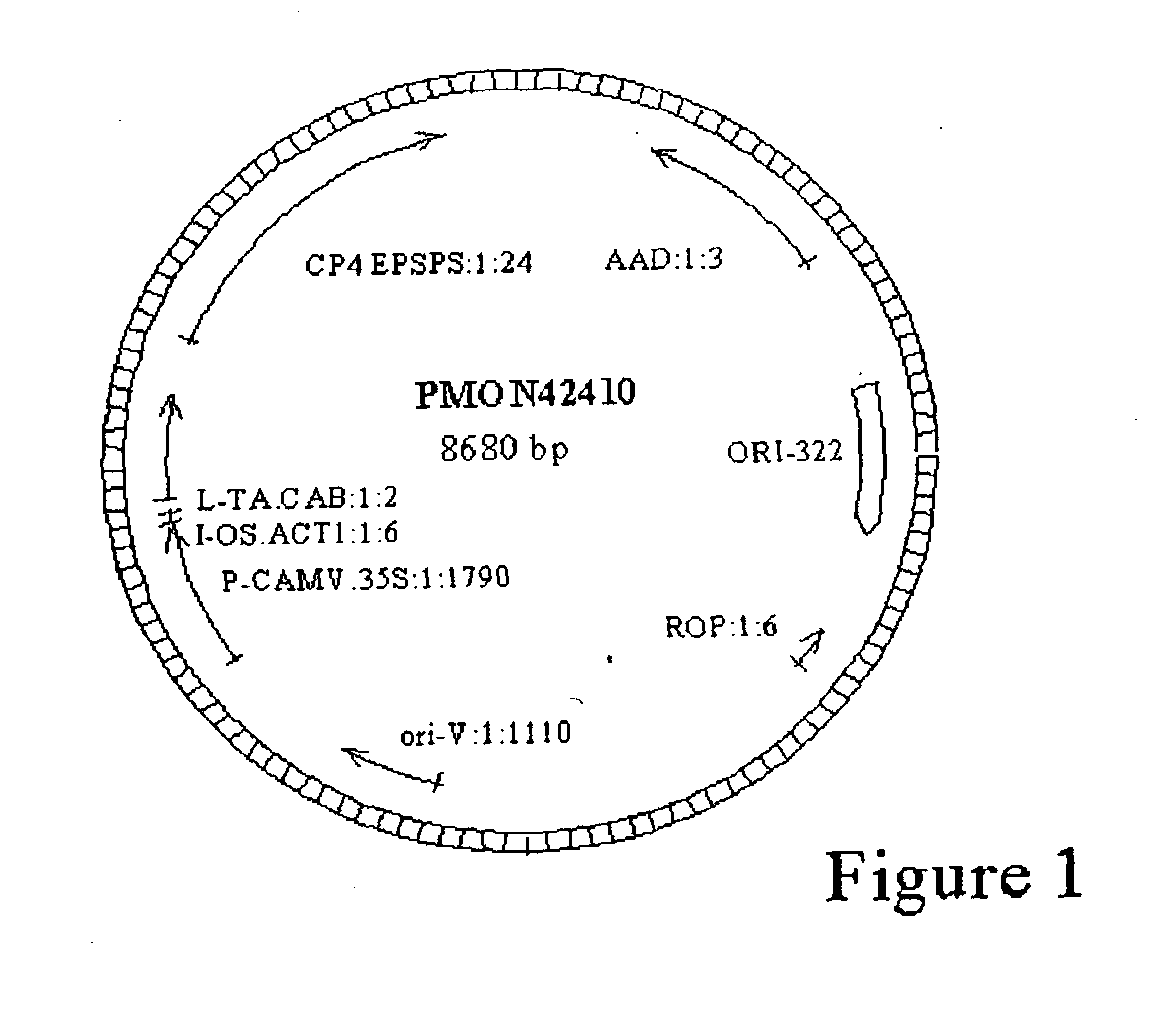Novel Method for Agrobacterium Preparation for Plant Transformation
a technology of agrobacterium and plant transformation, applied in the field of new agrobacterium preparation for plant transformation, can solve the problem of limiting the flexibility of planning transformation experiments
- Summary
- Abstract
- Description
- Claims
- Application Information
AI Technical Summary
Benefits of technology
Problems solved by technology
Method used
Image
Examples
example 1
[0046] Bacterial Strains and Plasmids
[0047] Agrobacterium tumefaciens strain ABI is harbored with binary vectors pMON42410 (FIG. 1) or pMON42411 (FIG. 2) or pMON42073 (FIG. 3) or pMON18365 (FIG. 4). The T-DNA of the vectors contain a neomycin phosphotransferase II gene (nptII) or CP4 EPSPS (glyphosate) as the selectable marker and a green fluorescence protein gene (gfp) or GUS as the screenable marker, driven by 35S promoter or the rice actin 1 promoter (P-RACT1) or the FMV promoter.
example 2
[0048] Preparation of Agrobacterium for Corn Protocols
[0049] Agrobacterium ABI in glycerol stock is streaked out on solid LB medium supplemented with the antibiotics kanamycin (100 mg / L), spectinomycin (100 mg / L), streptomycin (100 mg / L) and chloramphenicol (25 mg / L) and incubated at 28.degree. C. for 2 days. Two days before Agrobacterium inoculation, one loop of Agrobacterium cells from the LB plate is picked up and inoculated into 50 mL of liquid LB medium supplemented with 100 mg / L each of spectinomycin and kanamycin in a 250-mL flask. The flask is placed on a shaker at approximately 150 rpm and 27.degree. C. overnight. The Agrobacterium culture is then diluted (1 to 5) in the same liquid medium and put back to the shaker. Several hours later in the late afternoon one day before inoculation, the Agrobacterium cells are spun down at 3500 rpm for 15 min. The bacterium cell pellet is re-suspended in induction broth with 200 .mu.M of acetosyringone and 50 mg / L spectinomycin and 50 mg...
example 3
[0051] Transformation of type I callus of an inbred corn line
[0052] Inoculation and co-culture: Immature embryos (1.0-2.0 mm) are isolated from sterilized ears and dipped into Agrobacterium cell suspension in 1.5-mL microcentrifuge tubes continuously for 15 minutes. The tube is then set aside for 5 min. After the Agrobacterium suspension is removed using a transfer pipette with fine tip, the embryos are transferred to standard co-culture medium (Table 1). The embryos are placed with the scutellum side facing up. The embryos are cultured in a Percival incubator set at 23.degree. C. and dark for approximately 24 h.
[0053] Selection and regeneration and growth: After the co-cultivation, the embryos are transferred from the co-culture plates onto callus induction medium, induction MS (Table 1) with 500 mg / L carbenicillin and 100 or 200 mg / L paromomycin. The plates are kept in a dark culture room at 27.degree. C. for approximately 2 weeks. Two weeks later, almost all the callus pieces dev...
PUM
| Property | Measurement | Unit |
|---|---|---|
| temperature | aaaaa | aaaaa |
| period of time | aaaaa | aaaaa |
| period of time | aaaaa | aaaaa |
Abstract
Description
Claims
Application Information
 Login to View More
Login to View More - R&D
- Intellectual Property
- Life Sciences
- Materials
- Tech Scout
- Unparalleled Data Quality
- Higher Quality Content
- 60% Fewer Hallucinations
Browse by: Latest US Patents, China's latest patents, Technical Efficacy Thesaurus, Application Domain, Technology Topic, Popular Technical Reports.
© 2025 PatSnap. All rights reserved.Legal|Privacy policy|Modern Slavery Act Transparency Statement|Sitemap|About US| Contact US: help@patsnap.com



